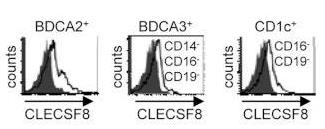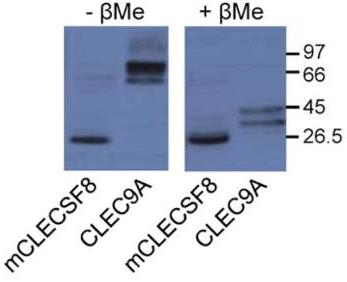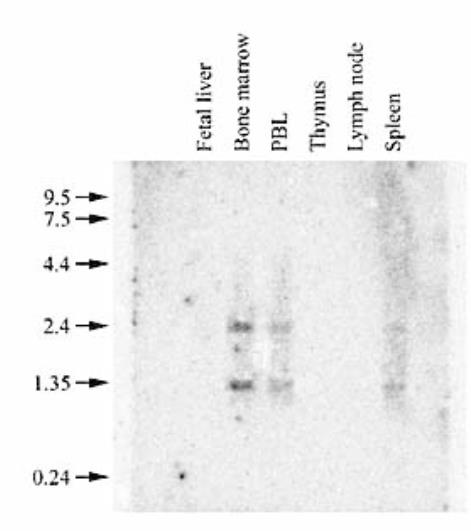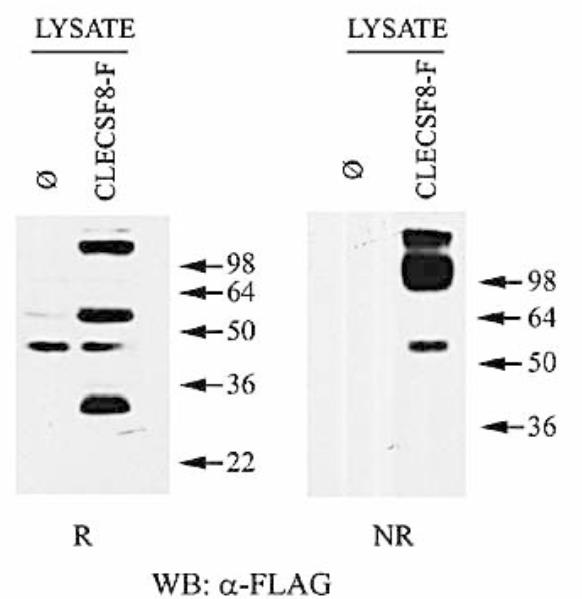Recombinant Human CLEC4D protein(Gly52-Asn215), His-tagged
| Cat.No. : | CLEC4D-3209H |
| Product Overview : | Recombinant Human CLEC4D (NP_525126.2) (Gly 52-Asn 215) was expressed in HEK293, with a polyhistidine tag at the N-terminus. |
- Specification
- Gene Information
- Related Products
- Case Study
- Application
- Download
| Species : | Human |
| Source : | HEK293 |
| Tag : | His |
| Protein Length : | 52-215 a.a. |
| Form : | Lyophilized from sterile PBS, pH 7.4. Normally 5 % - 8 % trehalose, mannitol and 0.01% Tween80 are added as protectants before lyophilization. |
| Molecular Mass : | The recombinant human CLEC4D consists of 180 amino acids and has a calculated molecular mass of 21.2 kDa. In SDS-PAGE under reducing conditions, rhCLEC4D migrates as several bands with apparent molecular mass of 21-27 kDa due to different glycosylation. |
| Endotoxin : | < 1.0 EU per μg of the protein as determined by the LAL method |
| Purity : | > 92 % as determined by SDS-PAGE |
| Storage : | Samples are stable for up to twelve months from date of receipt at -20°C to -80°C. Store it under sterile conditions at -20°C to -80°C. It is recommended that the protein be aliquoted for optimal storage. Avoid repeated freeze-thaw cycles. |
| Reconstitution : | It is recommended that sterile water be added to the vial to prepare a stock solution of 0.2 ug/ul. Centrifuge the vial at 4°C before opening to recover the entire contents. |
| Publications : |
MICL controls inflammation in rheumatoid arthritis. (2016)
|
| Gene Name | CLEC4D C-type lectin domain family 4, member D [ Homo sapiens ] |
| Official Symbol | CLEC4D |
| Synonyms | CLEC4D; C-type lectin domain family 4, member D; C type (calcium dependent, carbohydrate recognition domain) lectin, superfamily member 8 , CLECSF8; C-type lectin domain family 4 member D; Mpcl; C-type lectin receptor; macrophage C-type lectin; C-type lectin-like receptor 6; C-type lectin superfamily member 8; C-type (calcium dependent, carbohydrate-recognition domain) lectin, superfamily member 8; MCL; MPCL; CLEC6; CLEC-6; CLECSF8; MGC40078; |
| Gene ID | 338339 |
| mRNA Refseq | NM_080387 |
| Protein Refseq | NP_525126 |
| MIM | 609964 |
| UniProt ID | Q8WXI8 |
| ◆ Recombinant Proteins | ||
| CLEC4D-797H | Recombinant Human CLEC4D Protein, His-tagged | +Inquiry |
| CLEC4D-058H | Recombinant Human CLEC4D Protein, His-tagged | +Inquiry |
| CLEC4D-3209H | Recombinant Human CLEC4D protein(Gly52-Asn215), His-tagged | +Inquiry |
| CLEC4D-1101R | Recombinant Rat CLEC4D Protein, His (Fc)-Avi-tagged | +Inquiry |
| CLEC4D-2159HF | Recombinant Full Length Human CLEC4D Protein, GST-tagged | +Inquiry |
| ◆ Cell & Tissue Lysates | ||
| CLEC4D-1006RCL | Recombinant Rat CLEC4D cell lysate | +Inquiry |
| CLEC4D-2242HCL | Recombinant Human CLEC4D cell lysate | +Inquiry |
| CLEC4D-1487RCL | Recombinant Rat CLEC4D cell lysate | +Inquiry |
Case 1: Graham LM, et al. J Biol Chem. 2012
CLECSF8, initially thought to be only on macrophages, is mainly on neutrophils and monocytes. It disappears when monocytes become dendritic cells or macrophages in the lab. Though it lacks a signaling adaptor for expression in non-myeloid cells, in myeloid cells, CLECSF8 activates Syk kinase, prompting actions like phagocytosis and cytokine production. It acts as an activation receptor with an unknown adaptor, but its exact function is still unclear from studies on CLECSF8-deficient mice.

Fig1. Analysis of hCLECSF8 expression on various DC subpopulations in isolated PBMCs.

Fig2. Anti-HA Western blot analyses of RAW264.7 cells expressing HA-tagged mCLECSF8 or hCLEC9A.
Case 2: Arce I, et al. Eur J Immunol. 2004
Cell surface lectin receptors are key in macrophage functions. Researchers identified human CLECSF8, similar to mouse Mcl/Clecsf8, coding for a glycoprotein in the C-type lectin family. CLECSF8, found on chromosome 12 near MINCLE, features a single carbohydrate recognition domain but lacks known signaling motifs. It's mainly expressed in monocytes and macrophages. Studies show it as a 30 kDa glycoprotein that quickly internalizes upon cross-linking, indicating its role as an endocytic receptor.

Fig1. Northern blot analysis of CLECSF8 expression on total RNA from several immune tissues.

Fig2. Western blot analysis of 293 cell lysates transfected with CLECSF8-FLAG or the vector alone (Φ).
Not For Human Consumption!
Inquiry
- Reviews
- Q&As
Ask a Question for All CLEC4D Products
Required fields are marked with *
My Review for All CLEC4D Products
Required fields are marked with *
Inquiry Basket


